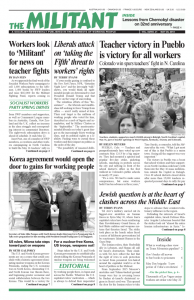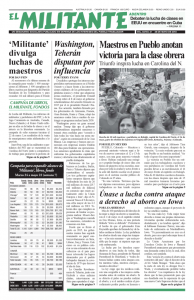PUEBLO, Colo. — Teachers and paraprofessionals here voted up new contracts May 12-13 by a big majority. They had mounted a spirited and popular five-day strike, picketing schools, marching in protests across the city and rallying in front of the school district’s office in the first walkout in Colorado’s public schools in nearly 25 years.
“It’s a win. We had to make some compromises, but some workers hadn’t had an advance in three years,” Tina Gurule, a counselor, told the Militant after the vote. “What I got most out of this is that Pueblo is a union town. Seeing all the support was very important.”
The victory in Pueblo was a boost that school workers and their supporters in North Carolina could carry with them into the May 16 mass mobilization outside the Capitol in Raleigh. Over 40 school districts closed down after more than 15,000 teachers requested personal days to rally for pay raises and increased school funding.
From a fight in West Virginia in February, through strikes and mass actions, the teacher uprising has rolled through Oklahoma, Kentucky, Arizona, Colorado and North Carolina. Union and nonunion workers have marked the fights with creativity, distrust of legislators of all stripes, and new forms of rank-and-file organizing. They have been inspired by and learned from each other and fought for unity across union and professional lines. They have welcomed and involved other workers in what has had elements of a broad social movement.
“We came out of this stronger,” Suzanne Ethredge, president of the Pueblo Education Association, told the Militant May 15. “School administrators were arrogant. They didn’t expect the strike.”
She said that of 1,017 teachers there, 775 are union members and 600 voted to walk out. A majority of the 150-member paraprofessionals union went out too. The five-day strike had a deep impact on them all. Several teachers on probation initially went to work, but decided to walk out to join the picket line.
“Words can never fully express the bond that you develop with the people who walk the strike line with you,” Tessa Armijo, a teacher at Goodnight Elementary School, told the May 13 Pueblo Chieftain. “We went through so many powerful emotions together and were very cognizant of the fact that our own success relied heavily on the people we stood shoulder to shoulder with.”
Increasing numbers of teachers wore buttons reading, “Pueblo is a union town.”
Pueblo school workers had been working without an agreement since August. Under state law, the May 12 bargaining session between the union and the school board had to take place in public. So more than 30 students and union members filled the gallery, some shouting out questions and “advice” to the board. Outside the building hundreds more rallied and cheered.
Teachers will get a 2 percent Cost of Living Adjustment retroactive to January, rising to 2.5 percent in September. Paraprofessionals will get a one-time $500 payment in June and a 3.25 percent COLA in September. Workers will get paid for three days of the strike and get two personal days.
On May 9, the third day of the strike, more than 1,000 people — parents, teachers, students and members of area unions — filled up the entire River Walk park. They looked like a sea of pink, the color of the strike.
Ethredge said teachers started wearing pink T-shirts 20 years ago. “Administrators didn’t like them, so we continued wearing them,” she said.
There is a long history of labor battles in Pueblo. The massive EVRAZ steel mill here was built over 100 years ago and run by the Colorado Fuel and Iron Company. Strikes and battles took place for decades in the company’s surrounding coal mines and in the mill. The number of workers at EVRAZ today is a pale reflection of the past, but many steelworkers joined the teachers’ protests.
A lot of strikers said they were struck by how many workers thanked them for standing up.
“I saw this coming,” Josephine Munoz, a certified nursing assistant, told the Militant outside the Pueblo Central High School May 15. One of her children is a student there. “They had to strike to get what they deserved. The administrators did all they could to turn the parents against the teachers. It didn’t work.”
Thousands march in North Carolina
Thousands of teachers and their supporters started filling downtown Raleigh early May 16, marching up Fayetteville Street to North Carolina’s Capitol. Over 20,000 people from big cities and small towns across the state marched in the morning, demanding pay raises, increased school funding, more staff and smaller classes.
It was already the largest teachers’ protest in state history. At least 42 school districts, including the state’s six largest, canceled classes for the day, affecting close to 1 million students. Over the last couple of weeks, teachers and their supporters built the action and held meetings to make lunches for students who will miss school.
“We are not alone in this,” Pat Travis, a retired teacher, told 30 people at a meeting organized by the Wake County Association of Educators May 12. “We should discuss with our co-workers that we are part of a bigger movement, aligned with teachers in West Virginia, Arizona and other places who are fighting and winning. This should give us the courage to stand up, build a leadership and win.”
North Carolina is a right-to-work state and has one of the lowest rates of unionization in the country. Trying to scare school workers or weaken support for them with union-baiting hasn’t worked.
“Let’s call this what it is, Teacher Union thugs want to control the education process!” said state Rep. Mark Brody from Union County in a Facebook post May 11. “I don’t want Union County schools … to turn into Chicago. Let the Union thugs get their way now and we are half way there.”
More than 1,000 teachers in the county responded by requesting a personal day for the May 16 rally, forcing the district to close.
The teachers, school workers and union movement come out stronger.
Anna Rosen contributed to this article from North Carolina.


